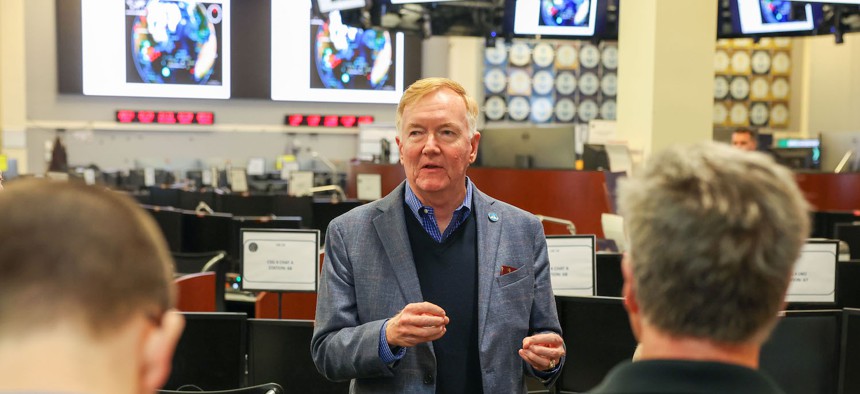
James Foggo III, a retired admiral participating in Large Scale Exercise (LSE) 2023, talks with reporters at the Naval Warfare Development Center in Norfolk, Virginia, on Aug. 11, 2023. U.S. Fleet Forces Command
What happens when a crisis sprawls between combatant commands?
That’s just one of the questions that the Navy’s global Large Scale Exercise aims to answer.
NAVAL STATION NORFOLK—The U.S. military divides up the world into giant commands, but what happens when enemy activities cross those lines? Large Scale Exercise 23 is attempting to figure out what the Navy and Marine Corps can do about it.
The globe-spanning, live-virtual-constructive wargame “recognizes that we're a global Navy, and that the threats are global also. And you’ve seen recent real-world examples where our competitors are more increasingly cooperating with one another, and are more increasingly sailing and operating further afield,” Adm. Sam Paparo, the commander of U.S. Pacific Fleet, told reporters Aug. 11.
Paparo said this “underscores the need for Large Scale Exercise” and the need to train “to find, track, and monitor potential threats, and to do so across the globe among commanders, whose headquarters are linked at all times.”
Just days into the exercise, its scenario was already applying pressure on the military’s unified command plan, which dictates how the military trains, resources, and controls its forces geographically, and which “our adversaries and competitors understand this perfectly well,” said Adm. Daryl Caudle, the commander of U.S. Fleet Forces Command.
“So it is in their best interest to see if there's a soft underbelly there at those seams and work those seams to understand whether or not [we] are well coordinated to handle cross flow coordination. Because that, in this type of level of conflict and this type of exercise, is really the most challenging part,” Caudle said. “It's easy to operate your own forces within your own operational area. Now, it may be challenged because, you know, war-is-hell kind of thing. But from a conceptual—being able to command and control forces effectively in a structure that's not necessarily designed to do that well, there is great learning and value there.”
Caudle said the Navy has already made a lot of progress in coordinating between commands because its forces operate across oceans where command boundaries meet.
The exercise, which runs from Aug. 9 until Aug. 18, is spread across seven U.S. fleets and six Navy and Marine Corps component commands, each with their own needs and priorities within the scenario. To keep everyone on the same page, the commanders attend synchronization meetings to report what challenges they are dealing with, what help they may need, and how to get resources from one another or from higher military organizations, Caudle said.
“They've devoted this level of time and effort with their staffs, because of the understanding we need to be able to have this same sight picture and they actually work together at this level. Because against a peer competitor that we're talking about, all the fights are going to be global,” he said. “And so it'd be completely shooting behind the duck if we try to just regionalize the type of the strategic competitors that we're talking about.”
Adm. Stuart Munsch, the commander of U.S. Naval Forces Europe, said the exercise is also incorporating observations from recent real-world events—some just hours old.
“[W]e’re very cutting-edge out here, watching what's going on in the world…and very quickly adopting the behaviors we see, and the performance we see in technology,” Munsch said. “I can't go into the specifics there, but it's something as recent as what I was briefed on this morning, I folded into the exercise this afternoon.”
Some of the initial lessons and recommendations from LSE23 will be documented in an after-action report, then analysts from the Center for Naval Analysis will tease out more in a larger report. CNA's report from the inaugural 2021 exercise was about 800 pages long, Caudle said.
There will be plenty to digest, said Scott Swift, the retired admiral who leads the exercise’s steering group.
“This is about looking at man, train and equip, mission functions task, and assessing is the training continuum working?,” Swift said. “I mean, we are testing these—we're taking it to the edge of what we think the force can do, and then pushing the force beyond it…This is about learning. We all want to win. But you know all this wargaming thing, ‘Well, we didn't win that war game.’ We're going to push this thing until that it's really hard for them to win. We want to find the failure points.”


